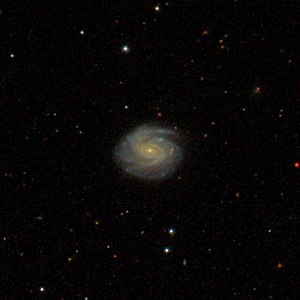NGC 5118
| Galaxy NGC 5118 / IC 4236 |
|
|---|---|

|
|
| SDSS recording | |
| AladinLite | |
| Constellation | Virgin |
|
Position equinox : J2000.0 , epoch : J2000.0 |
|
| Right ascension | 13 h 23 m 27.4 s |
| declination | + 06 ° 23 ′ 33 ″ |
| Appearance | |
| Morphological type | SBc |
| Brightness (visual) | 13.7 mag |
| Brightness (B-band) | 14.4 mag |
| Angular expansion | 0.8 ′ × 0.7 ′ |
| Position angle | 100 ° |
| Surface brightness | 12.9 mag / arcmin² |
| Physical data | |
| Redshift | 0.023269 ± 0.000127 |
| Radial velocity | 6976 ± 38 km / s |
|
Stroke distance v rad / H 0 |
(310 ± 22) x 10 6 ly (95.0 ± 6.7) Mpc |
| history | |
| discovery | Wilhelm Herschel |
| Discovery date | May 12, 1793 |
| Catalog names | |
| NGC 5118 • IC 4236 • UGC 8413 • PGC 46782 • CGCG 044-078 • MCG + 01-34-019 • IRAS 13209 + 0639 • 2MASX J13232747 + 0623338 • GC 3516 • H III 925 • h 1591 • GALEX ASC J132327.50 +062333.8 | |
NGC 5118 = IC 4236 is a 13.7 mag bright bar -spiral shaped radio galaxy of the Hubble type "SBc" in the constellation Virgo on the ecliptic . It is estimated to be 310 million light years from the Milky Way and about 75,000 light years in diameter.
The object was discovered twice; first on May 12, 1793 by Wilhelm Herschel with an 18.7-inch reflecting telescope, who described it as "cF, S" (listed as NGC 5118 ). The second discovery followed on May 22, 1897 by Lewis A. Swift (listed as IC 4236 ).
